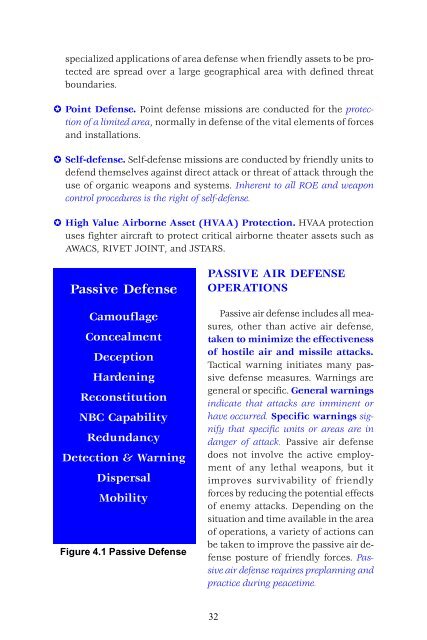Air Force Doctrine Document 2-1.1
Air Force Doctrine Document 2-1.1
Air Force Doctrine Document 2-1.1
Create successful ePaper yourself
Turn your PDF publications into a flip-book with our unique Google optimized e-Paper software.
specialized applications of area defense when friendly assets to be protected<br />
are spread over a large geographical area with defined threat<br />
boundaries.<br />
❇ Point Defense. Point defense missions are conducted for the protection<br />
of a limited area, normally in defense of the vital elements of forces<br />
and installations.<br />
❇ Self-defense. Self-defense missions are conducted by friendly units to<br />
defend themselves against direct attack or threat of attack through the<br />
use of organic weapons and systems. Inherent to all ROE and weapon<br />
control procedures is the right of self-defense.<br />
❇ High Value <strong>Air</strong>borne Asset (HVAA) Protection. HVAA protection<br />
uses fighter aircraft to protect critical airborne theater assets such as<br />
AWACS, RIVET JOINT, and JSTARS.<br />
Passive Defense<br />
Camouflage<br />
Concealment<br />
Deception<br />
Hardening<br />
Reconstitution<br />
NBC Capability<br />
Redundancy<br />
Detection & Warning<br />
Dispersal<br />
Mobility<br />
Figure 4.1 Passive Defense<br />
PASSIVE AIR DEFENSE<br />
OPERATIONS<br />
Passive air defense includes all measures,<br />
other than active air defense,<br />
taken to minimize the effectiveness<br />
of hostile air and missile attacks.<br />
Tactical warning initiates many passive<br />
defense measures. Warnings are<br />
general or specific. General warnings<br />
indicate that attacks are imminent or<br />
have occurred. Specific warnings signify<br />
that specific units or areas are in<br />
danger of attack. Passive air defense<br />
does not involve the active employment<br />
of any lethal weapons, but it<br />
improves survivability of friendly<br />
forces by reducing the potential effects<br />
of enemy attacks. Depending on the<br />
situation and time available in the area<br />
of operations, a variety of actions can<br />
be taken to improve the passive air defense<br />
posture of friendly forces. Passive<br />
air defense requires preplanning and<br />
practice during peacetime.<br />
32
















